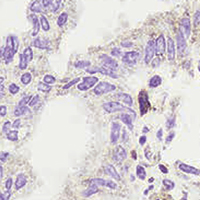The lncRNA MEG3 promotes trophoblastic cell growth and invasiveness in preeclampsia by acting as a sponge for miR-21, which regulates BMPR2 levels

Submitted: 6 September 2021
Accepted: 19 October 2021
Published: 25 November 2021
Accepted: 19 October 2021
Abstract Views: 1276
PDF: 495
HTML: 22
HTML: 22
Publisher's note
All claims expressed in this article are solely those of the authors and do not necessarily represent those of their affiliated organizations, or those of the publisher, the editors and the reviewers. Any product that may be evaluated in this article or claim that may be made by its manufacturer is not guaranteed or endorsed by the publisher.
All claims expressed in this article are solely those of the authors and do not necessarily represent those of their affiliated organizations, or those of the publisher, the editors and the reviewers. Any product that may be evaluated in this article or claim that may be made by its manufacturer is not guaranteed or endorsed by the publisher.
Similar Articles
- ChenHui Zhu, LiJuan Lin, ChangQing Huang, ZhiHui Wu, Activation of Hedgehog pathway by circEEF2/miR-625-5p/TRPM2 axis promotes prostate cancer cell proliferation through mitochondrial stress , European Journal of Histochemistry: Vol. 68 No. 4 (2024)
- A. Makowiecka, A. Simiczyjew, D. Nowak, A.J. Mazur, Varying effects of EGF, HGF and TGFβ on formation of invadopodia and invasiveness of melanoma cell lines of different origin , European Journal of Histochemistry: Vol. 60 No. 4 (2016)
- C. Di Nisio, V.L. Zizzari, S. Zara, M. Falconi, G. Teti, G. Tetè, A. Nori, V. Zavaglia, A. Cataldi, RANK/RANKL/OPG signaling pathways in necrotic jaw bone from bisphosphonate-treated subjects , European Journal of Histochemistry: Vol. 59 No. 1 (2015)
- K. Fujikawa, T. Yokohama-Tamaki, T. Morita, O. Baba, C. Qin, S. Shibata, An in situ hybridization study of perlecan, DMP1, and MEPE in developing condylar cartilage of the fetal mouse mandible and limb bud cartilage , European Journal of Histochemistry: Vol. 59 No. 3 (2015)
- S. Shibata, Y. Sakamoto, O. Baba, C. Qin, G. Murakami, B.H. Cho, An immunohistochemical study of matrix proteins in the craniofacial cartilage in midterm human fetuses , European Journal of Histochemistry: Vol. 57 No. 4 (2013)
- Azzurra Margiotta, Cinzia Progida, Oddmund Bakke, Cecilia Bucci, Characterization of the role of RILP in cell migration , European Journal of Histochemistry: Vol. 61 No. 2 (2017)
- W. Romero-Fernandez, D.O. Borroto-Escuela, V. Vargas-Barroso, M. Narváez, M. Di Palma, L.F. Agnati, J. Larriva Sahd, K. Fuxe, Dopamine D1 and D2 receptor immunoreactivities in the arcuate-median eminence complex and their link to the tubero-infundibular dopamine neurons , European Journal of Histochemistry: Vol. 58 No. 3 (2014)
- Cheng Chen, Yan Huang, Pingping Xia, Fan Zhang, Longyan Li, E Wang, Qulian Guo, Zhi Ye, Long noncoding RNA Meg3 mediates ferroptosis induced by oxygen and glucose deprivation combined with hyperglycemia in rat brain microvascular endothelial cells, through modulating the p53/GPX4 axis , European Journal of Histochemistry: Vol. 65 No. 3 (2021)
- Minkai Cao, Deping Yuan, Hongxiu Jiang, Guanlun Zhou, Chao Chen, Guorong Han, Long non-coding RNA WAC antisense RNA 1 mediates hepatitis B virus replication in vitro by reinforcing miR-192-5p/ATG7-induced autophagy , European Journal of Histochemistry: Vol. 66 No. 3 (2022)
- M. J. Galvão, A. Santos, M. D. Ribeiro, A. Ferreira, F. Nolasco, Optimization of the tartrate-resistant acid phosphatase detection by histochemical method , European Journal of Histochemistry: Vol. 55 No. 1 (2011)
You may also start an advanced similarity search for this article.

 https://doi.org/10.4081/ejh.2021.3323
https://doi.org/10.4081/ejh.2021.3323
















